One of the mistakes, or lazy things, I’ve done lately is let my carry ammo in my defense pistol get old. It’s been there for about 2 years, or more. If you carry a weapon for your safety and that of others, you should replace the ammo every 6 months to a year, depending on how you carry and how often you carry your gun. My gun is normally in a man bag so the ammo and weapon are not exposed to my skin or the weather very much, I could probably get away with a year. The more you abuse and use your gun, the more often you should replace the ammo.
Here is one way people abuse their ammo and don’t know it. Chambering and unloading your ammo is one of the most abusive things you could do to your ammo. If you load your gun and never unload it, you will not have this problem. The problem comes with a couple hundred loadings and unloadings. A lot of police officers and concealed carry holders come home everyday, unload their gun and put it away. The next day, they get their gun and load it again, using the same round that came out of the chamber the day before.
You don’t realize how much force the gun creates when it chambers a round. The slide smacks the back of the round with the force of a hammer and pushes it incredibly fast into the chamber. Then the round is stopped by the front of the chamber with enough force to leave a mark. When the round comes out, a small steal claw grabs the lip of the brass and rips it out of the chamber and a little punch shoves it out of the gun. After a while the lip of the brass will wear down and the round may not come out of the chamber after being fired. When the round is shoved into the chamber, the only thing holding the bullet on the end is a little pressure. After a while the bullet will be pushed into the brass more and more. Once it goes in too far, it changes the pressure created when the round is fired and can lock up the gun. All this is also happening to the primer. The primer is the part the firing pin hits to fire the round. Once the primer is damaged the round generally will never fire. That could be really bad if you have to use your gun to defend yourself.
I hope I’ve convinced you to rotate your carry ammo to ensure that it will work if you ever need it. When you do rotate out your ammo, you want to make sure the ammo is good. Today’s ammo is incredibly good, but there are still chances of some bad ammo making it into a box. Here is what I do to check ammo I’m going to carry to defend myself.
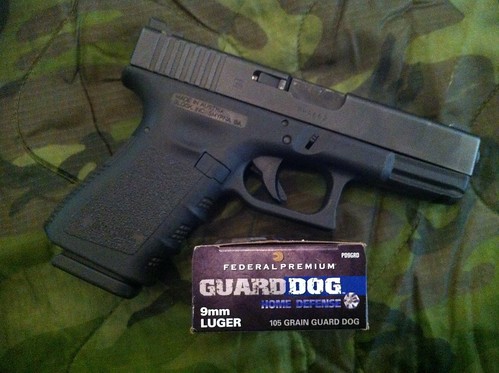
First, I look at the box. I won’t buy boxes that look they where used as a step stool. A case of ammo feels really solid, but if someone steps on the side of the box they can crush a round.
Next open the box and look closely at all the rounds. You can see in my picture how there is a discolored one. I really don’t know why it’s different than the others, but that one won’t make it into my carry gun.
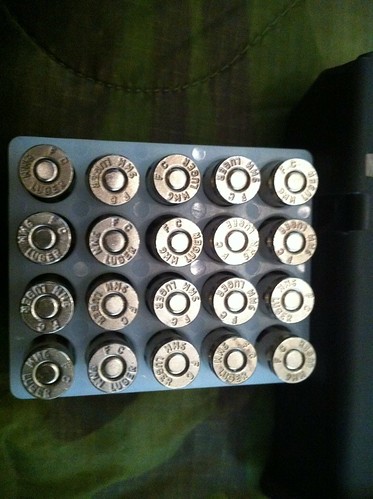
Also, look at each primer and then look level with the tops of the ammo. You are looking for something that is the wrong shape or the primer sticking up. A primer sticking higher than the case head is a problem and that round shouldn’t go into your carry gun, because it may not fire.
Next, put them all on the bottom, or head so the bullet is facing up on a hard level surface. You are looking for one that is longer or shorter than the rest. If you see one is, it will be pretty obvious. The more obvious the size difference the better the chances that the round will not fire, may not chamber, and may even lock up your gun after being chambered or fired.
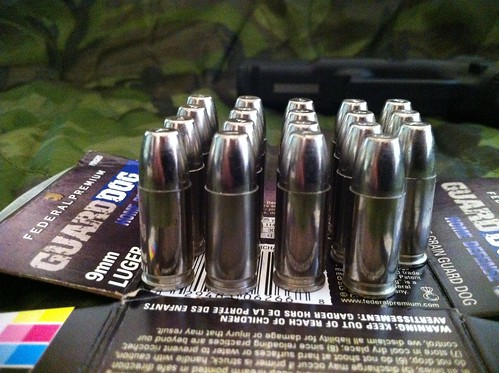
Lastly for those of you that are totally committed to your safety, take apart your carry gun. In fact, field strip any gun this ammo might be used in. I know some guys carry a couple different pistols but will use the same ammo from gun to gun. I used to carry two guns that took the same magazines as an armored car guard, so I would take apart both pistols. Just take the barrel from each gun and drop each round into the chamber individually.
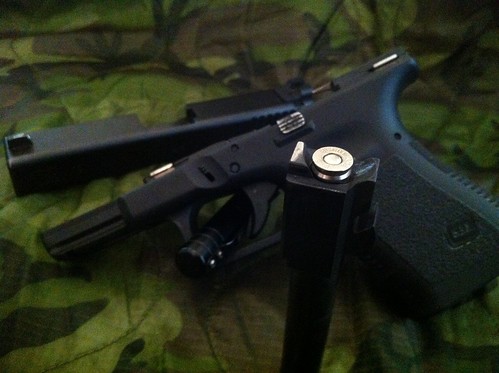
Look at how the round sits in the barrel. All the rounds should look exactly the same in the chamber. If one looks different or sticks out, or goes too far in, that round should not be used for defense. If the round doesn’t go all the way in, you could get one that won’t fire. What I’m more looking for is one that doesn’t go in and out like the rest. That means the round is oversized and could lock up the gun during firing.
As I handle each round, I’m also looking at the shell it self to see if there is any damage, cracks, discoloration, or anything that looks abnormal. I’m not this careful with my practice or competition ammo, only with the ammo I might have to use to defend my life. I found this one when I was thumbing rounds into a magazine.
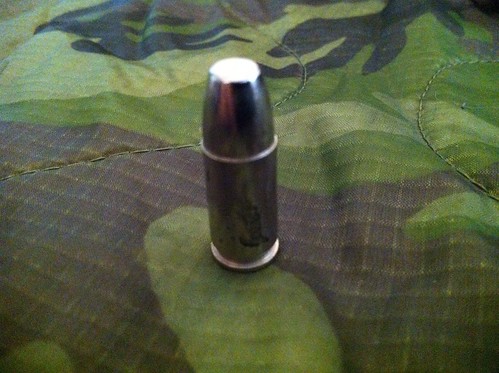
If you find dirt or the like on the brass, if it wipes off with your finger not a big deal, but clean it before you put it into a magazine. If it won’t wipe off, don’t bother trying to clean it any further, don’t put it into your carry gun. I don’t know what this is on this round, but it won’t be going into carry gun. I’ll shoot it in practice.
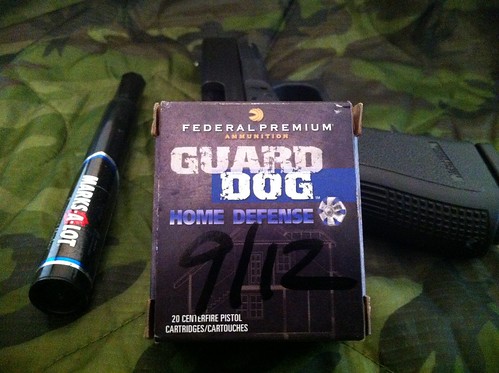
A little trick I picked up years ago to remember when I put ammo in my gun is to keep one of the boxes with the couple rounds you have left over, because there is always a couple, and write the month and year on the box of when you bought the ammo. Any ammo that I plan on storing for any reason I put the date on the outside of the box.
While we are on the subject about new ammo, I’m totally crazy when it comes to getting the right amount of rounds in a magazine. This box replaced the 15 rounds in my carry gun and the one in the chamber. So I count the rounds coming out of the box (15) and put them all in my hand or on the table in front of me. I count them as I put them into the magazine, and then will check the holes in the back of the magazine to ensure that I got all 15 rounds in the magazine. I know this sounds crazy, but I’ve been to too many competitions where people don’t load their magazines correctly, and when it comes to the gun I’m going to depend my life on, I want everything as perfect as I can make it.
Stay Safe,
Ben
Interesting look at the Guard Dog, Ben.
Looks like the Guard Dog didn’t make the top choices on this gel tested list though. https://www.ammunitiontogo.com/lodge/best-9mm-ammo-for-self-defense/
Have you tested the Guard Dog at all to see how it stacks up HSTs and others?
Greetings,
My name is Mike Leard and I have a new style of speed loader strip for revolvers coming out in less than a month, the website for it is thespeedstrip.com we’re just getting started and I think they’re going to sell like hotcakes. I am also the inventor of the Maxfire Revolver Speedloader.
I went to Afgainastain and it didn’t take me long to get hurt and with the money I got out of the ordeal I’ve patented this revolver speedstrip and am looking for both gun shops and gun accessories distributors to carry this new speedloader.
They are caliber specific not revolver specific so they fit all 38/357 revolvers regardless of the revolvers frame. Some revolver grips are too big for use with a round speedloader; you can use any revolver grip with this new style speedstrip, it comes in both 38/357 and 22 caliber.
The 22 is the single largest most fired ammunition in the world so it only made good sense to that these two calibers lead the way. The 38/357 caliber also fit 41caliber revolvers.
Here’s what you get, a 3 pack of either 38/357 or 22 caliber speedstrips retail for $13.99 a package plus shipping and handling, California residents please add $1.17 sales tax.
They’re Unbreakable and have a Lifetime Guarantee, no questions ask!
Thanks for letting me say something, wish me luck.
http://www.thespeedstrip.com/
So, for those of us that unload every night and reload the next morning, what do you recommend to reduce the stress on the ammo?
Here’s what I do:
I have any extra magazine with about 5 extra SD rounds in it. When I load up in the morning, I chamber a round from that magazine. The 5-round mag is then removed from the gun. Then, my fully loaded carry magazine gets put in the gun and the gun is holstered.
When I unload at night, I’ll remove the carry magazine and rack the slide several times (ejecting the round that was chambered). The ejected round then goes in a box and the gun goes in the safe. The carry magazine is stored in a separate, secure location.
After I’ve used all 5 rounds in my extra magazine, I’ll reload it from the box of ammo. I figure this spreads the stress of load/unloading across several rounds and will hopefully keep any one of them from malfunctioning.
Do you recommend just keeping the gun loaded? I would certainly consider this, but it just feels strange given all of the “gun safety” information out there tells you to store the gun and ammo separately.
Thanks for your input and for the post!
Jason, first I would challenge the reason for loading and unloading the weapon every night. Most safety stuff says unload for storage, I wouldn’t call overnight storage. If you the gun isn’t going to be in your control, the safe is a great place for it. I keep my every-day carry loaded in the safe. In the Military and Law Enforcement I found that the number one time for a negligent discharge was during loading and unloading. And it wasn’t the new soldier/cop, it was the guy that did it everyday for years on end that would make the mistake. The two guns I carry everyday just stay loaded. In fact for a long time I wore an IWB holster that had clips. To take off the gun at night, I would simply leave the gun in the holster, pull it off as one unit, and put then entire package in the safe. Next morning I would put the entire thing back on, do one draw so I could do a press check, put it back in the holster, and be ready for the day.
If you are going to load and unload your gun everyday (and I did overseas for dry practice) you need to cycle the round going into the chamber as much as possible. Just 5 rounds might not be enough. Consider emptying your mags and rotating through all your ammo. There isn’t an easy way to do this, besides unloading the magazine and rotating it. You could also think about rotating your ammo more often, like every 4 or 5 monts instead of 6 to 12. Overseas I did both. I would rotate my top and bottom ammo in the mag at least once a week and I would get new ammo at least once a month (I would shoot my duty ammo and get new stuff). And when you are rotating your ammo in the magazines from top to bottom it gives you another opportunity to inspect the ammo.
My bottom line is that I don’t unload my carry weapon just to unload it. I only unload it for a reason. I have kept a loaded gun in my safe for over a decade now and it works for me. But, I am the only one that has access to my safe and I treat every weapon as if it were loaded.
Good answer. Thanks!
This was an excellent informative article.
You definitely changed the way I look at my carry gun, and how often I’ll be changing, inspecting, and making sure my ammo is correct and on point.
I do fieldstrip my .45 (Glock 30) regularly, and my girlfriend’s 9MM (Ruger LC9 as well), to try and keep them clean basically after each visit to the range or after about a month or so of carrying concealed.
I also have a 12 gauge — would you say some of these principles apply to 12 gauge ammunition since it’s so different??
12 Gauge is definitely different. The initial inspection should be the same but other things are different. First I would say for defense, don’t use anything but High-Brass ammo. I’ve had major issues with low-recoil ammo that has low brass like a practice load. If you are storing the shotgun in a controlled environment like your safe or bedroom the ammo will last for ever if you aren’t pulling it in and out of the gun. I have ammo in my shotgun that is probably about time to change and it’s about 10 years old. The dead giveaway on a shotgun shell, besides the obvious damage, is when the white stuff starts coming out of the front of the shell. Other then that, they should be good.
Keep an eye out for damage, and if you take your shotgun on the road with you all the time, consider changing them at the same rate you do your handgun. It’s all about how much abuse you give the rounds. If they just stay in your gun in your safe, you should think every 10 years depending on humidity. Inspection is the key, and if you ever think they might be bad, replace them.
Thanks for the reply Ben!
I got your e-mail too.
I like how thorough you are in your explanations, and how detailed you are when it comes to specific types of ammunition, and time frames, etc.
Thanks for the tip on the low-recoil ammunition too — ironically that’s *exactly* what I had in my 12 gauge right now.
I was using the Fiocci brand low-recoil rounds.
I switched to the Remington “Home-Defense” rounds after reading what you said. =0)
You are welcome. You can still use low recoil stuff, I just wouldn’t use low brass stuff. I’m hoping that’s what you ment. You are welcome for the email and everything. I’m just enjoying answering questions.